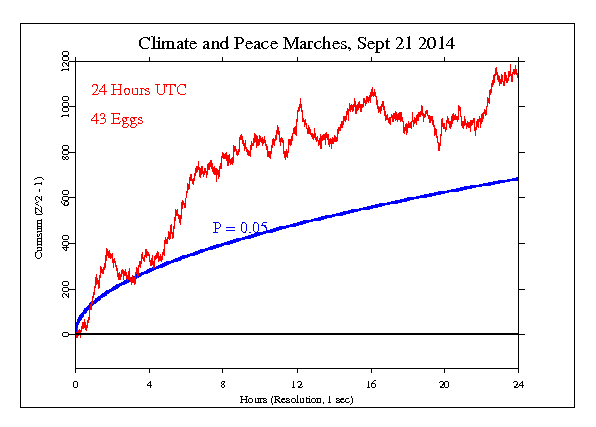Climate and Peace Activism, Sept 21 2014
Standard analysis
September 21 2014 was a day for many kinds of demonstrations, especially for climate change. It was promoted by many organizations such as Avaaz.org, 350.org, worldpeacepoetry.com and the focus included world peace and a brighter future in general.
For example, Hundreds of thousands of demonstrators marched through Manhattan on Sunday to demand bold action to combat global warming. Sen. Bernie Sanders joined the march that organizers said drew 400,000 people. Bernie and Sen. Barbara Boxer are the co-sponsors of the most comprehensive climate change legislation in Congress – a bill that puts a tax on carbon and billions of dollars into energy efficiency and sustainable energy. In interviews in New York City, Bernie said that it was an international embarrassment that the Republican Party was blocking almost all efforts to reduce carbon emissions. “You have a major political party that is rejecting science and is impeding us at every step of the way," said Bernie, who serves on the Senate energy and environment committees. “The only way to put pressure on government is to do exactly what we are doing today—taking to the streets.”
Bernie praised fellow Vermonter Bill McKibben, who founded the international environmental group 350.org. “Bill and all those who worked with him to organize this extraordinary demonstration know that the only way we defeat the powerful fossil fuel companies, and reduce carbon emissions, is when people around the globe take to the streets and demand action from their governments. Sunday’s march was a great step forward in that effort.”
Specific hypothesis and results
The GCP hypothesis was set for the full 24 hour GMT day of Sept 21. The result is Chisquare 87535.423 on 86400 df, for p = 0.003 and Z = 2.721.
Interpretation
The following graph is a visual display of the statistical result. It shows the second-by-second accumulation of small deviations of the data from what's expected. Our prediction is that deviations will tend to be positive, and if this is so, the jagged line will tend to go upward. If the endpoint is positive, this is evidence for the general hypothesis and adds to the bottome line. If the endpoint is outside the smooth curve showing 0.05 probability, the deviation is nominally significant. If the trend of the cumulative deviation is downward, this is evidence against the hypothesis, and is subtracted from the bottom line. For more detail on how to interpret the results, see The science and related pages.

Standard caveat
It is important to keep in mind that we have only a tiny statistical effect, so that it is always hard to distinguish signal from noise. This means that every “success” might be largely driven by chance, and every “null” might include a real signal overwhelmed by noise. In the long run, a real effect can be identified only by patiently accumulating replications of similar analyses.
